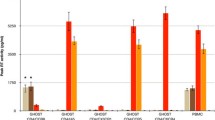Summary
The C-terminal cytoplasmic tail of chemokine receptors is important for their internalization upon ligand binding. We generated several deletion mutants of the C-terminal cytoplasmic tail of CXCR-4, a co-receptor for T cell line tropic strains of human immunodeficiency virus type 1 (HIV-1), to know whether or not co-receptor internalization is associated with HIV-1 entry. Our data showed that the removal of C-terminal 15 amino acid residues of the cytoplasmic tail from CXCR-4 completely abolished its internalization, but did not affect the co-receptor activity at all. Co-receptor activity was fully retained even when all 45 amino acid residues in the C-terminal cytoplasmic tail had been deleted. These data indicated that no cytoplasmic tail nor internalization of CXCR-4 is required for its co-receptor activity for HIV-1 entry.
Similar content being viewed by others
Author information
Authors and Affiliations
Additional information
Accepted January 16, 1998 Received December 9, 1997
Rights and permissions
About this article
Cite this article
Hu, H., Shioda, T., Hori, T. et al. Dissociation of ligand-induced internalization of CXCR-4 from its co-receptor activity for HIV-1 Env-mediated membrane fusion. Arch. Virol. 143, 851–861 (1998). https://doi.org/10.1007/s007050050337
Published:
Issue Date:
DOI: https://doi.org/10.1007/s007050050337




